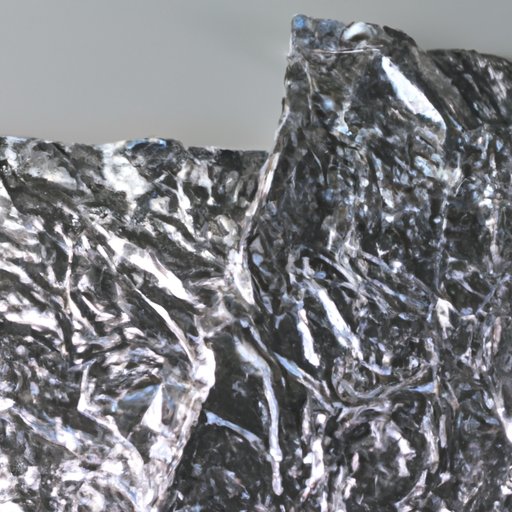Introduction
Aluminum foil is one of those kitchen staples that can be found in almost every home. It’s used to cover leftovers, wrap sandwiches and burgers, and line baking sheets. But what happens when you’re done with it? Is aluminum foil recyclable?
The answer is yes! In fact, recycling aluminum foil is an important part of reducing waste and preserving resources. In this article, we’ll look at the importance of recycling aluminum foil, how it can be recycled, the benefits of recycling, common misconceptions about aluminum foil and recycling, how to dispose of used aluminum foil, the impact it has on the environment, and tips for reusing and recycling.
How Aluminum Foil Can Be Recycled
Before aluminum foil can be recycled, it needs to be separated from other materials such as food waste and plastic wrap. Once the foil has been separated, it can be taken to a local recycling center. Most centers accept aluminum foil, but it’s always best to check beforehand.
When the aluminum foil reaches the recycling center, it is shredded into small pieces and placed in a large vat. The vat is heated until the aluminum melts and separates from any impurities. The molten aluminum is then poured into molds to form ingots or blocks. The ingots are then sent to factories where they are melted down again and turned into new products such as cans, foil, and foil containers.
Benefits of Recycling Aluminum Foil
Recycling aluminum foil offers both economic and environmental benefits. Recycling aluminum requires 95% less energy than producing it from raw materials. This means that fewer fossil fuels are burned, resulting in lower greenhouse gas emissions. Additionally, recycling aluminum helps reduce the amount of landfills and reduces air and water pollution.
Recycling also helps to conserve natural resources. Aluminum is one of the most abundant elements on Earth, but it still takes a great deal of energy to extract it from ore. By recycling aluminum, fewer resources need to be extracted and processed, which helps to conserve energy and preserve the environment.

Common Misconceptions About Aluminum Foil and Recycling
There are several misconceptions about aluminum foil and recycling that need to be addressed. One common misconception is that aluminum foil is not recyclable. As mentioned above, aluminum foil can be recycled, but it does need to be separated from other materials before it can be recycled.
Another misconception is that aluminum foil should not be recycled because it is too expensive. While it is true that there is a cost associated with recycling aluminum foil, the benefits far outweigh the costs. Not only does recycling aluminum help conserve resources and reduce pollution, but it also helps to create jobs and boost the economy.

What to Do With Used Aluminum Foil
If you don’t have access to a recycling center, there are other ways to reuse or dispose of used aluminum foil. One option is to reuse the foil. Aluminum foil can be reused multiple times if it is washed and stored properly. Another option is to compost the aluminum foil. Aluminum foil is biodegradable and will break down over time, making it safe to add to a compost pile.
If neither of these options is available, aluminum foil can be safely disposed of in the trash. Be sure to double bag it to prevent it from blowing away and littering the environment.
The Impact of Aluminum Foil on the Environment
Aluminum foil is used all over the world, and its production has a significant impact on the environment. According to the World Steel Association, global aluminum production reached 62 million metric tons in 2018. Producing this amount of aluminum requires large amounts of energy, which contributes to air and water pollution.
Additionally, the mining of bauxite, the primary ore used to make aluminum, can cause soil erosion and water contamination. Bauxite mining also destroys habitats and disrupts ecosystems. These are just a few of the environmental impacts of aluminum production.

Tips for Reusing and Recycling Aluminum Foil
There are several strategies for reducing aluminum foil waste. One way is to buy aluminum foil in bulk. Buying in bulk reduces the amount of packaging waste and saves money in the long run. Another way is to use reusable containers instead of aluminum foil whenever possible.
When it comes to reusing aluminum foil, there are several options. Aluminum foil can be used to line baking sheets, wrap sandwiches and burgers, and cover leftovers. It can also be used to store food in the refrigerator and freezer, and to keep spices and herbs fresh. Finally, aluminum foil can be used to sharpen scissors and clean pots and pans.
Conclusion
Recycling aluminum foil is an important part of reducing waste and preserving resources. It offers economic and environmental benefits, and helps to conserve energy and preserve the environment. There are several misconceptions about aluminum foil and recycling, but these can easily be dispelled by understanding the facts. Finally, there are several strategies for reducing aluminum foil waste, such as buying in bulk and using reusable containers. With a little bit of effort, we can all do our part to reduce aluminum foil waste and protect the environment.

